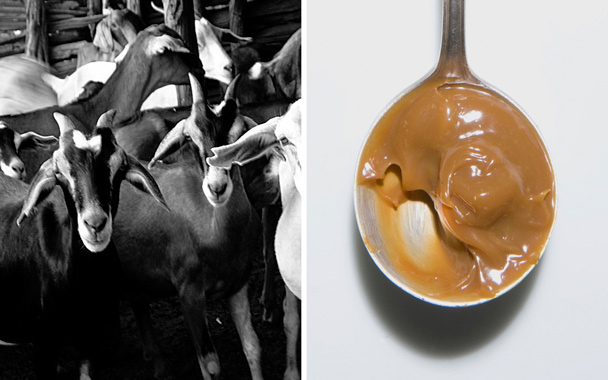Here’s the delicious part of the story:
A couple weeks ago, I noticed that my favorite goat cheese purveyors at the Greenmarket had started bringing fresh goat’s milk to sell along with their cheese. I snapped up a quart without knowing exactly what I’d do with it because, after all, it’s cold and things are disappearing from the market in droves. I thought about feeding it to the toddler for a change but decided to make dessert instead.
Cajeta is a sweet milk caramel eaten all over Latin America. (It’s called cajeta in Mexico; elsewhere it goes by dulce de leche, manjar, and arequipe, among other things.) It can be made from canned sweetened condensed milk, but making it from fresh milk isn’t hard and might be more fun.
All you need to do is add a cup of sugar to a quart of milk in a heavy pot and put it over medium heat. (Goat’s milk is traditional, but cow’s milk works fine too.) As soon as the mixture starts boiling, remove it from the heat and add a quarter teaspoon of baking soda. The liquid will froth furiously for a minute or so. When it’s done, put it back on the heat and simmer it vigorously for a long time—count on two hours—stirring from time to time. It’ll start browning after an hour, but you want to wait until it’s khaki-colored or darker, about half the volume you started with, and slightly sticky. Let it cool, and store it in the fridge or use it immediately. Rich like butterscotch, sweet from its milky origins and savory from the caramelization, you may just want to spread it on toast and eat it every morning. We served it over bread pudding, which I can highly recommend.
And here’s the dorky part of the story:
I’d always thought the caramel in cajeta came from caramelized sugar but realized while making it that that couldn’t be exactly right, since sugar doesn’t caramelize until well above the boiling point of water (or milk). Next I thought it might be the other kind of caramelization—the Maillard reaction responsible for savory bread crusts and the appealing surface of steaks—acting on the proteins and carbohydrates in the milk and leaving the sugars untouched. But that couldn’t be right either, since the Maillard reaction doesn’t really get going until just above the boiling point (which is why boiled food doesn’t brown).
As usual, Harold McGee’s On Food and Cooking had the answer: True, the Maillard reaction starts at 220 degrees—unless the food is alkaline, in which case it starts closer to 210. It’s still a slow process, which is why it takes two hours to make cajeta, but it explains why you need baking soda to make cajeta. Now I can stop fussing and just enjoy the stuff.




 Pinterest
Pinterest


